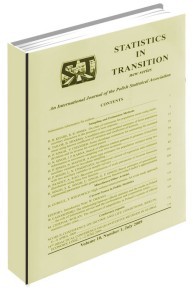IMPROVEMENT OF FUZZY MORTALITY MODELS BY MEANS OF ALGEBRAIC METHODS
IMPROVEMENT OF FUZZY MORTALITY MODELS BY MEANS OF ALGEBRAIC METHODS
Author(s): Andrzej Szymański, Agnieszka RossaSubject(s): Economy, National Economy, Public Finances, Socio-Economic Research
Published by: Główny Urząd Statystyczny
Keywords: C*-Banach algebra; non-commutative C*-algebra; quaternion algebra; fuzzy mortality model
Summary/Abstract: The forecasting of mortality is of fundamental importance in many areas, such as the funding of public and private pensions, the care of the elderly, and the provision of health service. The first studies on mortality models date back to the 19th century, but it was only in the last 30 years that the methodology started to develop at a fast rate. Mortality models presented in the literature form two categories (see, e.g. Tabeau et al., 2001, Booth, 2006) consisting of the so-called static or stationary models and dynamic models, respectively. Models contained in the first, bigger group contains models use a real or fuzzy variable function with some estimated parameters to represent death probabilities or specific mortality rates. The dynamic models in the second group express death probabilities or mortality rates by means of the solutions of stochastic differential equations, etc.The well-known Lee-Carter model (1992), which is widely used today, is considered to belong to the first group, similarly as its fuzzy version published by Koissi and Shapiro (2006). In the paper we propose a new class of fuzzy mortality models based on a fuzzy version of the Lee-Carter model. Theoretical backgrounds are based on the algebraic approach to fuzzy numbers (Ishikawa, 1997a, Kosiński, Prokopowicz and Ślęzak, 2003, Rossa, Socha and Szymański, 2015, Szymański and Rossa, 2014). The essential idea in our approach focuses on representing a membership function of a fuzzy number as an element of C*-Banach algebra. If the membership function μ(z) of a fuzzy number is strictly monotonic on two disjoint intervals, then it can be decomposed into strictly decreasing and strictly increasing functions (z), (z), and the inverse functions f(u)=−1(u) and g(u)=−1(u), u ∈ [0, 1] can be found.Ishikawa (1997a) proposed foundations of the fuzzy measurement theory, which is a general measurement theory for classical and quantum systems. We have applied this approach, termed C*-measurement, as the theoretical foundation of the mortality model. Ishikawa (1997b) introduced also the notions of objective and subjective C*-measurement called real and imaginary C*-measurements. In our proposal of the mortality model the function f is treated as an objective C*-measurement and the function g as an subjective C*-measurement, and the membership function μ(z) is represented by means of a complex-valued function f(u) + ig(u), where i is the imaginary unit. We use the Hilbert space of quaternion algebra as an introduction to the mortality models.
Journal: Statistics in Transition. New Series
- Issue Year: 18/2017
- Issue No: 4
- Page Range: 701-724
- Page Count: 24
- Language: English

